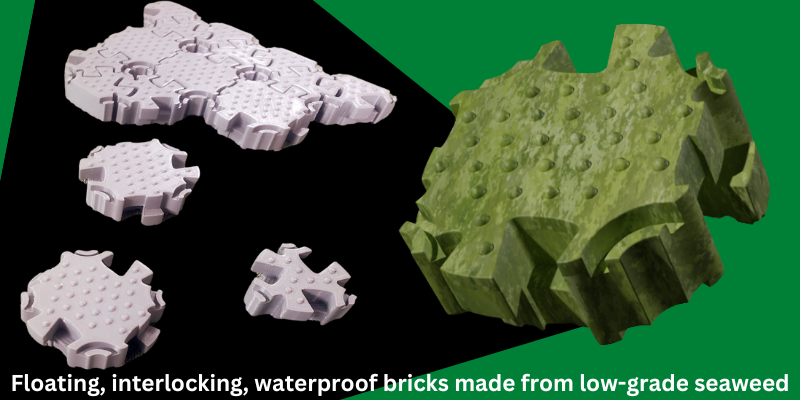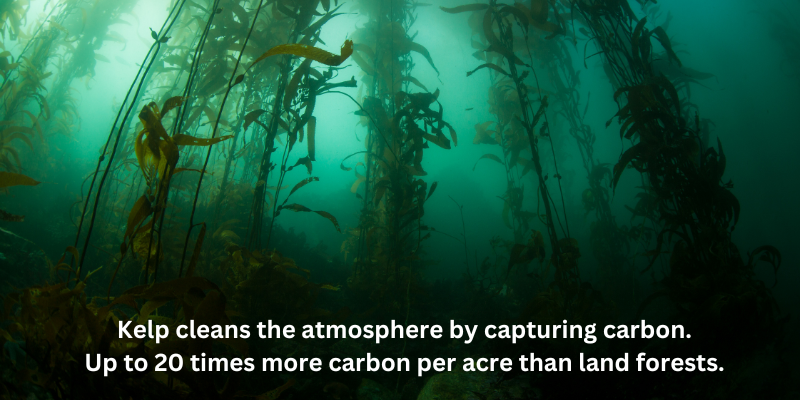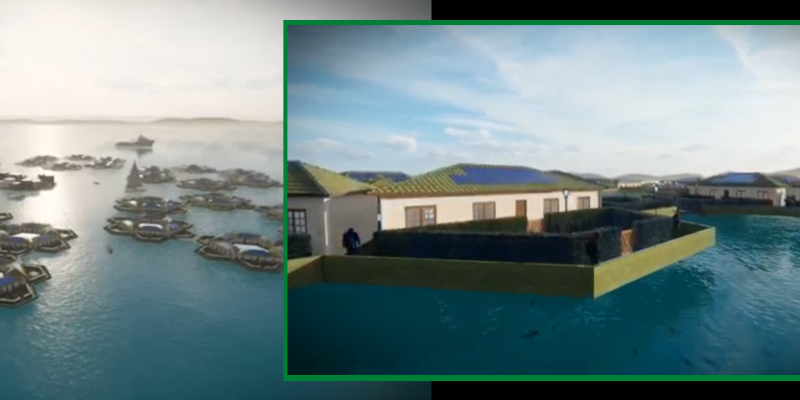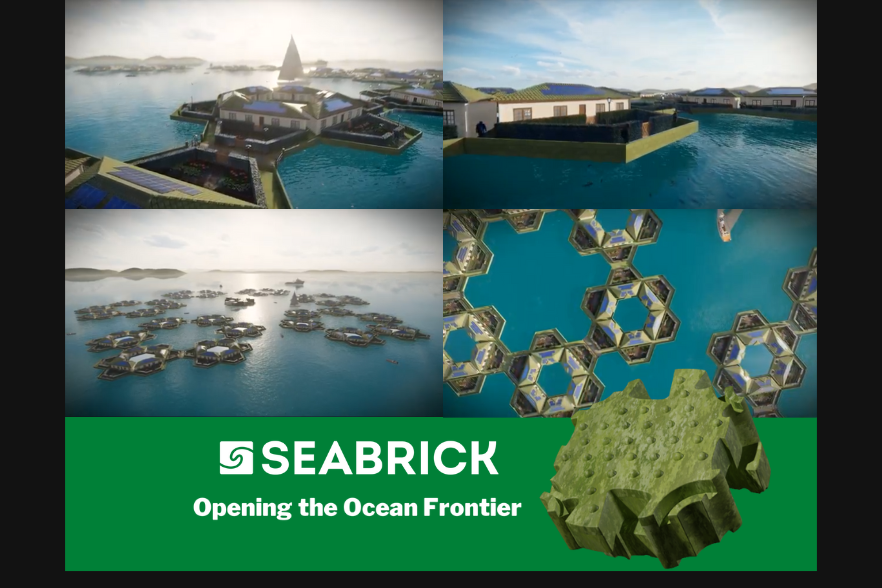Building your Seastead? Independence and freedom just got a lot less expensive…

SeaBrick takes us one step closer to affordable individual homesteads at sea. When used in its novel interlocking design, SeaBrick can be connected like uniquely-shaped legos to form a platform in a multitude of configurations to meet any need. This means everything from your tiny home at sea, to apartment buildings and merchant shops, are now eco-restorative and less expensive many times over. Because the main ingredient is kelp, it sequesters 400 kg (881 lbs) of carbon per ton.

“SeaBrick™ is a revolutionary new way of building on the ocean. SeaBrick is an interlocking, buoyant, brick system composed primarily of kelp biomass. SeaBrick is designed to permanently sequester carbon and address the human displacement impact of climate change.”
– SeaBrick™
The Seasteading Institute is happy to include SeaBrick as one of our Active Projects. You can chat with SeaBrick founder, John Richardson, in the SeaBrick channel in our Discord server.
John Richardson is an entrepreneur interested in Seasteading and the Blue Economy whose vision is to, “Use floating SeaBrick made from seaweed to decarbonize the global construction sector while supporting vulnerable coastal communities.” He believes this will aid in the survival of our planet as the use of SeaBrick will sequester millions of tons of CO2.
Every time a manufacturer creates a better product that goes into building your seastead, a host of related challenges can be solved. What makes SeaBrick such a game changer is that the costs are dramatically lower than other structural materials that could be used for your Seastead.
SeaBrick is also less expensive than other floating materials at $360 per ton.
SeaBrick vs. …
- Floating Concrete: SeaBrick is 72% less expensive per ton than Floating Concrete, which is $1,300 per ton. Floating Concrete emits 900 kg (1,984 lbs) per ton. Choosing floating concrete over SeaBrick means 1,300 more kg (2,866 lbs) of carbon in the environment per ton used for building.
- Aluminum Pontoons: SeaBrick is 83% less expensive per ton than Aluminum Pontoons which are $2,200 per ton. Aluminum Pontoons emit 2 tons of carbon. Choosing aluminum pontoons over SeaBrick means 2.44 tons more carbon in the environment per ton used for building.
- Steel Pontoons: SeaBrick is 58% less expensive per ton than Steel Pontoons, which are $866 per ton. Steel Pontoons also emit 2 tons of carbon. Choosing steel pontoons over SeaBrick means 2.44 tons more carbon in the environment per ton used for building.
These numbers are even lower in favor of SeaBrick if used to create hollow pontoons.
Another important comparison is how long SeaBrick will last. Like concrete, the application makes a difference. Testing of SeaBrick shows that it will last as long as concrete, perhaps longer in some applications. SeaBrick is also much easier to replace.
When it really comes down to it, cost is going to be a major roadblock for the average person who wants to seastead. SeaBrick helps to make seasteading more available to everyone.

4 Problems Solved by SeaBrick that positively impact our world.
Problem #1: Governments and nonprofits have been spending time and money cleaning up sargassum from their coastal waters. Sargassum is a brown macroalgae seaweed that is subject to overgrowth that can cause a lot of problems for local habitats and local economies. It is high in methane, ammonia, and hydrogen sulfide when it decomposes. You know that rotten egg smell that can greet you at the shore? That’s the hydrogen sulfide decomposing in the sargassum.
Solution: SeaBrick is made from sargassum. Harvesting sargassum for the manufacturing of SeaBrick not only cleans up the overgrowth in communities who are negatively impacted by it, but also provides the local communities with another income source. Turning an expense into an income is the kind of radical change that greatly improves the standard of living for those communities who adopt it.
Problem #2: The manufacturing of concrete, steel and aluminum damages the environment due to extraction and carbon emissions. Cement manufacturing accounts for 9% of global emissions. Steel manufacturing accounts for between 8% and 11% of global emissions, and aluminum accounts for 3% of global emissions. This is all in addition to the waste and energy used in the manufacturing process.
Solution: Not much feels better than turning a bad into a good. The manufacturing of SeaBrick will sequester carbon and decarbonize the construction sector. Seabrick requires little energy and heat to produce, and it actually sequesters carbon. SeaBrick is composed primarily of seaweed, which is dried, chopped up and combined with some biologically sourced additives and cast in a compression press. It is then coated with a non-toxic polymer.
Problem #3: The changing landscape. Some of our coastal communities are undergoing massive change, displacing people and industry.
Solution: Many of the people and businesses impacted by eroding shorelines and other impacts due to the overtaking by water of their communities, would rather stay than flee. SeaBrick can provide floating infrastructure for housing, business, and local governments.
Problem #4: Adoption of Blue and Green products by business and consumers is too slow or nonexistent in many sectors.
Solution: SeaBricks affordability and the fact that it is eco-restorative goes a long way in motivating builders and individuals to adopt a BLUE Solution for their building materials. However, they cannot adopt products like SeaBrick if they do not know about it and understand its value. Awareness and education are key, and will only come when people are aware of SeaBrick. Please share this post with anyone you think would be interested.
Summary:
SeaBrick is designed to:
- Build marine infrastructures of all kinds, from wave breaks and offshore platforms to floating homes and ocean-based communities
- Reduce pressure on land ecosystems
- Provide economic opportunities for coastal communities
- Restore ocean ecosystems
- Sequester carbon – and lots of it
The production, engineering and architectural possibilities are endless.

